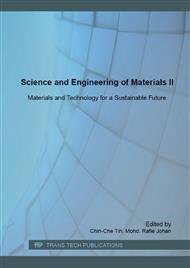p.3
p.8
p.13
p.18
p.23
p.28
p.33
p.42
p.47
Thermal Conductivity Enhancement of Graphene Epoxy Nanocomposite
Abstract:
Graphene was introduced in the epoxy matrix for the enhancement of thermal conductivity properties. Dispersion is a crucial step in nanocomposite processing. Therefore, it is important to tackle the issues and homogenously dispersed the graphene in the epoxy matrix. In this paper, we varied the stirring speed in order to understand its effects on enhancing the thermal conductivity values of the composites. Results show that the thermal conductivity increases up to 17.5% with the 1.5% weight loading of graphene that was stirred at 1500 rpm stirring speed. The experiment results are then compared to theoretical calculation by Maxwell model. Study implied that Maxwell model can predict the thermal conductivity of composites because it applies only for small volume fraction of filler. As the filler loading used in this study only up to 1.5 wt. %, Maxwell model was suitable to be used.
Info:
Periodical:
Pages:
13-17
Citation:
Online since:
July 2016
Keywords:
Price:
Сopyright:
© 2016 Trans Tech Publications Ltd. All Rights Reserved
Share:
Citation:


